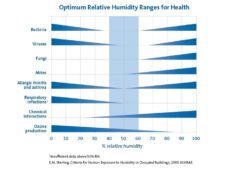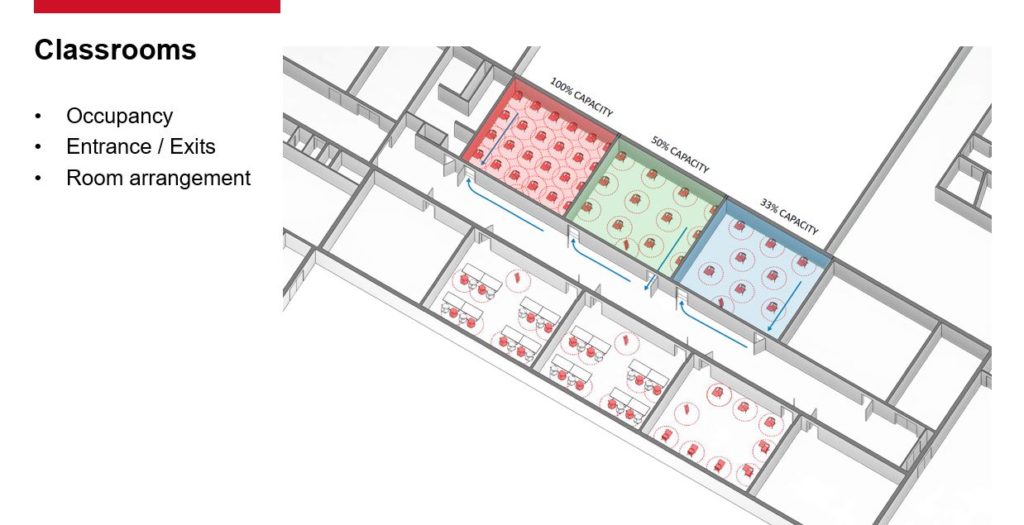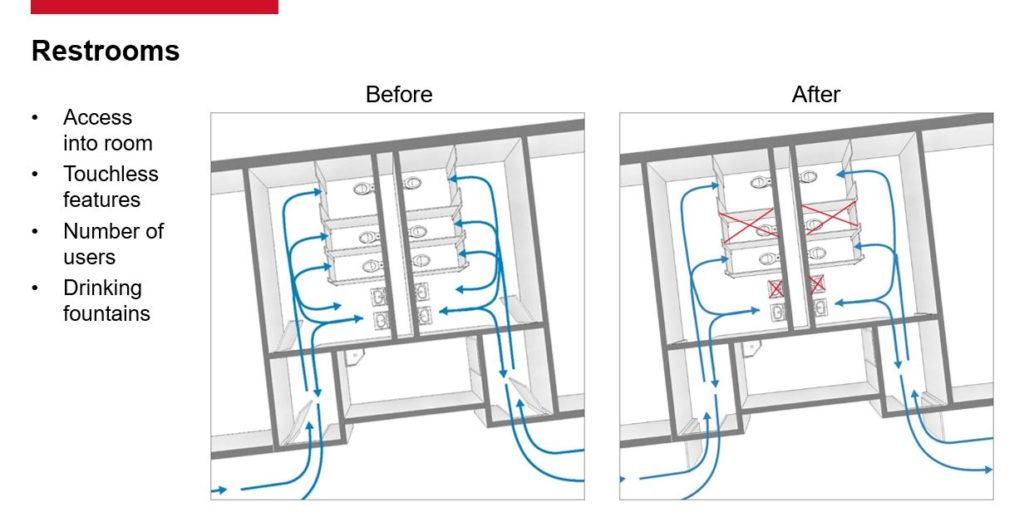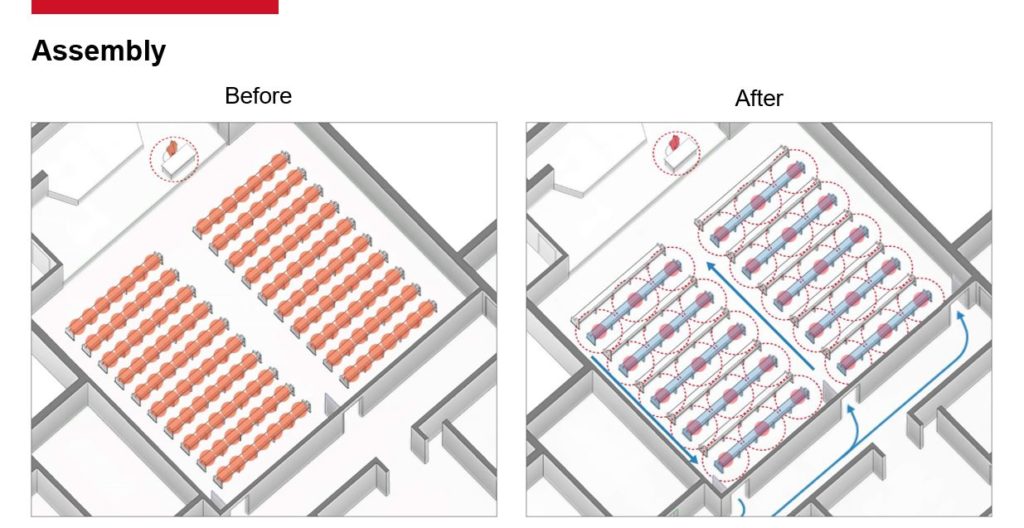Post-COVID: Preparing K-12 schools for student return
A combination of policy and physical changes can help keep students healthy when they return to schools.
Arrupe Virtual Learning Institute recently asked two of our design leaders to provide practical advice for transforming school buildings for a post-COVID student return. Observing guidance from the CDC, WHO, OSHA and others, Managing Principal Chris Johnson and Education Market Sector Leader Kristi Nohavec addressed physical changes to buildings as well as policies. The two work hand-in-hand. The presentation begins at 6:34 in the video below.
By Kristi Nohavec, P.E., AIA, LEED AP, and Chris Johnson, AIA, LEED AP, WELL AP
“We shape our buildings; thereafter, they shape us.” – Winston Churchill
Adapting the physical space inside school buildings
Existing school buildings vary in their age, condition and population. Consequently, there is no one-size-fits-all solution. The best solutions for enhancing resilience for a post-COVID return to school will be tailored to each building.
Classrooms
Most classrooms comprise about 900 square feet and house about 25 students. Safe spacing can be accomplished with fewer students per classroom by staggering and alternating schedules. The orientation of desks should be all facing the same direction, according to current guidance from the CDC. Ideally, additional open doorways will be added to direct the flow of traffic in a single direction in and out of each classroom.
These changes may present a challenge for some schools. The past decade has brought collaborative furniture into classrooms to facilitate a variety of activities and teaching styles. In specialized classrooms such as science labs, fewer students will be able to occupy lab stations to adhere to physical separation best practices.
Entries and Exits
Entries are the first “high-touch” point for most schools. Some schools may consider automatic door openers that activate as students approach. A lower tech alternative could be designated door “greeters” who open doors and welcome students, creating social contact in a new world of physical distancing.
School entryways double as the ideal location for a health station. Here, administrators could install temperature checks and wellness stations that include hand-sanitizer.
Exits, on the other hand, should multiply to allow students to disperse from the building with less crowding.
Corridors
Corridors ideally will be modified for one-way traffic. Multi-story school buildings simplify the physical changes needed to achieve this. Traffic can move in one direction down corridors on each level. Administrators should also limit the time students spend collectively in corridors.
Lavatories
Where sight lines allow, doors with high-touch points should be removed. Administrators should also consider assigning certain restrooms to smaller groups. For example, freshmen, sophomores, etcetera.
Toilets and sinks in most school restrooms are not a minimum six feet apart. Therefore, administrators should restrict access to every other fixture. Manual operations should be replaced by automated functions: motion-activated sinks and toilets. One exception to this rule is paper towel dispensers. After hand washing with soap and water, germs will be neutralized. In cases where they are not, a hand dryer would aerosolize them.
Assembly spaces (such as cafeterias)
Traditional food lines and salad bars will be replaced by prepackaged and pre-boxed meals. Depending on a variety of circumstances, students may eat lunch in a reconfigured cafeteria that creates space between them, or they may go back to their classrooms to eat. Lunch times should be staggered to accommodate physical distancing with fewer students in cafeterias at a given time.
Lockers are used by some students and not by others, even when they are assigned. Efforts should be made to minimize items brought back and forth between schools and homes in the post-COVID world. This may ultimately reduce the number of printed text books as schools increasingly leverage digital resources and technology.
Signage on floors and walls, as well as stand-alone signs, should clearly communicate instructions for students to stay physically distanced as they move through the post-pandemic school building.
Engineering systems
Engineering systems, especially electrical and mechanical systems, can be invisible forces that help keep students, faculty and staff safe and healthy. They vary widely between buildings. A century-old school building may have originally been designed around HVAC from windows that open and close. A newer building will have greater infrastructure for ventilation, heating and cooling. Throughout the years, building codes have increasingly refined engineering systems and they remain highly specific to individual buildings.
Ultraviolet lighting
We have already begun working with some clients to implement retrofit ultraviolet (UV) lighting systems that kill pathogens. They can be a high-level solution in spaces such as classrooms and gyms. In some instances, UV lighting already exists to a degree in air-handling units where moisture accumulates. However, these implementations are limited. Too much UV in an air-handling can impact air flow.
Relative humidity
 Maintaining relative humidity between 40 and 60 percent benefits human health, and research shows that it also reduces the “float” time of viruses that cause flu, colds and COVID-19. This is the subject of the website 40to60rh.com, created by Harvard M.D., Dr. Stephanie Taylor. Building codes traditionally center on thermal comfort rather than human health. As a result, most buildings operate at very low humidity – especially during the winter months. We were recently featured in Forbes and Architectural Digest for our research in modifying buildings for higher humidity. Learn more in our whitepaper or video.
Maintaining relative humidity between 40 and 60 percent benefits human health, and research shows that it also reduces the “float” time of viruses that cause flu, colds and COVID-19. This is the subject of the website 40to60rh.com, created by Harvard M.D., Dr. Stephanie Taylor. Building codes traditionally center on thermal comfort rather than human health. As a result, most buildings operate at very low humidity – especially during the winter months. We were recently featured in Forbes and Architectural Digest for our research in modifying buildings for higher humidity. Learn more in our whitepaper or video.
Technology
On July 13, the US started to see major school districts announce fall-semester plans in which students will not return to physical buildings in the fall. These determinations coincide with a decision to educate students remotely. A robust technology infrastructure is, and will be, increasingly critical. The use of 360-degree cameras, for example, can bring students into hands-on demonstrations for science classes, art or music instruction.
 About the author Kristi Nohavec, PE, AIA, LEED AP, leads the Education Market Sector for our Omaha design studio. Her insights have been published in CITYLAB and her leadership helps drive innovation across our Education portfolio. She is one of 14 individuals in Nebraska dual licensed as a registered architect and professional civil (structural) engineer. She is past recipient of the Outstanding Alumni of the Year Award from the University of Nebraska-Lincoln’s Architecture Friends Association. She has received the Distinguished Service Award from the American Institute of Architects and has been recognized as Engineer of the Year by the Eastern Chapter of the Nebraska Society of Professional Engineers. She spends much of her free time volunteering in the Omaha community, including mentoring women leaders through the American Legion Auxiliary’s Cornhusker Girls State.
About the author Kristi Nohavec, PE, AIA, LEED AP, leads the Education Market Sector for our Omaha design studio. Her insights have been published in CITYLAB and her leadership helps drive innovation across our Education portfolio. She is one of 14 individuals in Nebraska dual licensed as a registered architect and professional civil (structural) engineer. She is past recipient of the Outstanding Alumni of the Year Award from the University of Nebraska-Lincoln’s Architecture Friends Association. She has received the Distinguished Service Award from the American Institute of Architects and has been recognized as Engineer of the Year by the Eastern Chapter of the Nebraska Society of Professional Engineers. She spends much of her free time volunteering in the Omaha community, including mentoring women leaders through the American Legion Auxiliary’s Cornhusker Girls State.
 About the author Chris Johnson, AIA, LEED AP, WELL AP, is a registered architect with deep knowledge of both the design and construction industries, making him an exceptional leader and client steward. He has almost three decades of architecture and construction experience, including conceptual design, site design, design development, construction documents, document review and master planning for many of the region’s defining projects. Chris has served as president of the Omaha chapter of the American Institute of Architects and is a member of the Greater Omaha Chamber of Commerce Board of Directors, the Omaha-Council Bluffs American Heart Association Executive Leadership Team and the Downtown Omaha Rotary Club.
About the author Chris Johnson, AIA, LEED AP, WELL AP, is a registered architect with deep knowledge of both the design and construction industries, making him an exceptional leader and client steward. He has almost three decades of architecture and construction experience, including conceptual design, site design, design development, construction documents, document review and master planning for many of the region’s defining projects. Chris has served as president of the Omaha chapter of the American Institute of Architects and is a member of the Greater Omaha Chamber of Commerce Board of Directors, the Omaha-Council Bluffs American Heart Association Executive Leadership Team and the Downtown Omaha Rotary Club. 


